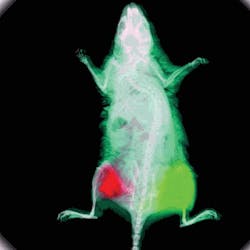Fluorescent labeling technique overcomes setbacks of GFP
A green fluorescent protein known simply as GFP has revolutionized cell biology. First isolated from a jellyfish in 1962, GFP allows scientists to track otherwise invisible proteins as they move about the cell, orchestrating processes such as cell division and metabolism. To achieve this, scientists tack the gene for GFP onto the gene for the protein they want to study. After the engineered gene is introduced into cells, it will produce proteins that glow fluorescent green.
However, GFP's large size (238 amino acids) can interfere with some proteins, such as actin, a molecule that helps give cells their structure and is involved in cell division, motility and communication with other cells.
MIT researchers have designed a fluorescent probe that can be targeted to different locations within a cell. Here, the probe is labeling only proteins in the cell membrane. (Image courtesy Katharine White and Tao Uttamapinant)
To overcome the drawbacks of GFP, the researchers used a blue fluorescent probe that is much smaller than GFP. Unlike GFP, the new probe is not joined to the target protein as it's produced inside the cell. Instead, the probe is attached later on by a new enzyme that the researchers also designed.
For this to work, the researchers must add the gene for the new enzyme, known as a fluorophore ligase, to each cell at the same time that they add the gene for the protein of interest. They also add a short tag (13 amino acids) to the target protein, and this tag allows the enzyme to recognize the protein. When the blue fluorescent probe (7-hydroxycoumarin) is added to the cell, the enzyme attaches it to the short tag on the target protein.
With this method, proteins such as actin can move freely throughout the cell and cross into the nucleus, even when tagged with the fluorescent probe.
The researchers also demonstrated that they can label proteins in specific parts of the cell, such as the nucleus, cell membrane or cytosol (the interior of the cell), by tagging the enzyme with genetic sequences that direct it to specific locations. That way, the enzyme attaches the fluorescent probe only to proteins in those locations.
The researchers describe the new technique, dubbed PRIME (PRobe Incorporation Mediated by Enzymes), in the Proceedings of the National Academy of Sciences.
- Chayasith Uttamapinant et al, Proceedings of the National Academy of Sciences. Week of May 30, 2010.
More Brand Name Current Issue Articles
More Brand Name Archives Issue Articles

